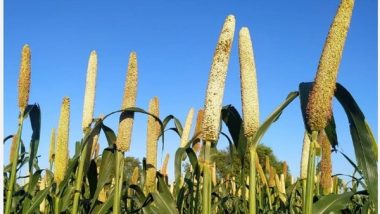Agartala (Tripura) [India], September 16 (ANI): In line with the United Nations Food and Agriculture Organisation's declaration of 2023 as the 'International Year of Millets,' the Department of Agriculture and Farmers' Welfare in Tripura is placing renewed emphasis on millet cultivation.
While millet, once dubbed the "poor man's food," has been a staple crop in the tribal areas of Tripura for centuries, the global recognition of its nutritional value is driving a resurgence in its cultivation.
Also Read | IndiGo's Mumbai-Doha Flight 6E 1303 Faces Technical Issue; Long Wait for Passengers Inside Plane.
Millets, including foxtail millet (locally known as Kaun), sorghum, ragi, and others, are small grains collectively cultivated in regions across India. Although these crops have traditionally been used by the poorer communities in southern and western India, they have long been grown in the hilly states of the Northeast, including Tripura, where bread and chhattu are common products made from millet. In addition to human consumption, millet also serves as animal feed.
However, the perception of millet is changing globally. With studies showing that millets have higher nutritional value than rice and wheat, demand for these grains is skyrocketing, both domestically and internationally. Doctors and nutritionists now recommend incorporating millets into the diet, citing their health benefits. In response, the Indian government has declared 2023 as the 'International Millet Year' to encourage its cultivation nationwide, including in Tripura.
Also Read | Maharashtra CM Eknath Shinde Says Positive Steps Will Be Taken To Include Dhangar Community in ST Category.
In Tripura, millet cultivation has been an integral part of farming practices in the Jhum system, particularly in tribal areas where foxtail millet has been grown for generations. Recent efforts by the Department of Agriculture have focused on expanding millet cultivation beyond traditional zones, with special initiatives in places like Pathalia and Golaghati in the Bishalgarh Agricultural Sub-division of Sipahijala district.
Farmers such as Kanai Sarkar, Uttam Bhowmik, and Sathi Rani Shil from the Bishalgarh sector have embraced millet cultivation. This season, four hectares of land in the area have been dedicated to millet, with expected yields ranging from 1300 kg to 1400 kg per hectare--similar to last year's production. The farmers expressed optimism about this year's harvest, noting that millet has proven to be a reliable crop, especially for summer months when water scarcity makes it difficult to grow other crops on their tila land.
Department of Agriculture, farmers have received financial subsidies, expert advice, and essential machinery to assist in harvesting and marketing millet. Farmers reported last year's success when 224 kg of millet per kani was sold at Rs100 to Rs130 per kg, indicating a promising profit margin.
While millet cultivation had declined over the years due to changing food preferences, the government and agricultural experts are now encouraging farmers to revive its production. By promoting millet as part of a balanced diet and supporting infrastructure development, the Department aims to boost farmers' incomes and increase food security in the region. As Tripura joins the rest of the country in celebrating the International Year of Millets, the state is poised for a millet cultivation revival, contributing to both local sustainability and global nutritional demands. (ANI)
(This is an unedited and auto-generated story from Syndicated News feed, LatestLY Staff may not have modified or edited the content body)












 Quickly
Quickly
















